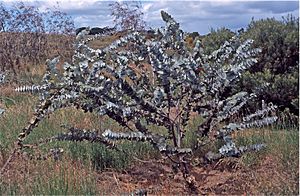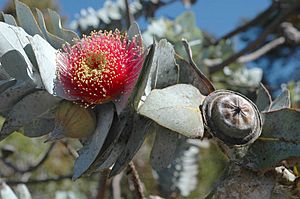Rose mallee facts for kids
Quick facts for kids Rose mallee |
|
|---|---|
 |
|
| Cultivated specimen | |
| Conservation status | |
| Scientific classification | |
| Genus: |
Eucalyptus
|
| Species: |
rhodantha
|
The Rose Mallee (Eucalyptus rhodantha) is a special type of tree or shrub. It is found only in Western Australia. This plant is known for its smooth bark and beautiful red flowers. Sometimes, these flowers can even be creamy white! The Rose Mallee has unique heart-shaped leaves that grow directly on its stem. Its fruits hang down and look like small, woody bells.
Contents
What the Rose Mallee Looks Like
The Rose Mallee is a small tree or a shrub. It usually grows between 1.5 and 4 meters (about 5 to 13 feet) tall. It has smooth bark that can be grey or pinkish.
Its leaves are very special. They are heart-shaped and grow right on the stem without a stalk. They are arranged in pairs opposite each other. The leaves are a dull silver-grey color on both sides. They are egg-shaped, about 4.5 to 8 centimeters (1.8 to 3.1 inches) long. They are also about 3 to 7.5 centimeters (1.2 to 3 inches) wide.
The flower buds grow one by one where the leaves meet the stem. They hang downwards on a stalk. This stalk is about 1 to 2 centimeters (0.4 to 0.8 inches) long. The mature buds are egg-shaped and have a greyish-white coating. They are about 2.8 to 5.3 centimeters (1.1 to 2.1 inches) long.
The Rose Mallee flowers from July or September to December or January. Its flowers are usually red, but sometimes they can be creamy white. After flowering, the plant produces woody fruits. These fruits hang down and are shaped like a hemisphere or a cone. They are about 1.6 to 2.8 centimeters (0.6 to 1.1 inches) long.
How the Rose Mallee Got Its Name
The Rose Mallee was first officially described in 1938. Two scientists, William Blakely and Henry Steedman, wrote about it. They found the plant near a place called Gunyidi in Western Australia.
The scientific name rhodantha comes from ancient Greek words. "Rhoda" means "rose colored," and "anthos" means "flower." So, rhodantha means "rose-flowered," which perfectly describes its beautiful red blooms!
Where the Rose Mallee Lives
The Rose Mallee is only found in a few small areas in Western Australia. These areas are near towns like Three Springs and Watheroo. Some reports suggested it grew further south, but these plants were actually hybrids. This means they were a mix of the Rose Mallee and other eucalyptus types.
Most of the places where the Rose Mallee grows are on private land that has been cleared for farming. Some plants are found along degraded road edges. Only two groups of plants are in areas that haven't been cleared.
The Rose Mallee likes flat or slightly hilly land. It grows in sandy or gravelly soils. The climate in these areas is similar to a Mediterranean climate. This means it has hot summers and cool winters. Most of the rain falls from May to August.
Rose Mallee's Life Cycle
The large flowers of the Rose Mallee can be up to 7.5 centimeters (3 inches) across. They are bright red to pink, and sometimes yellow. The woody fruits are shaped like a spinning top. They are about 3 centimeters (1.2 inches) long and 5.5 centimeters (2.2 inches) wide. These fruits contain dark brown, winged seeds.
The Rose Mallee flowers mostly in winter, from June to August. Unlike many other eucalyptus plants, it doesn't produce many flowers on each plant. Each flower can last for a long time, about 20 to 30 days. They also make a lot of sweet nectar during the day.
The flowers are pollinated by birds and small mammals. These include the white-fronted honeyeater and the honey possum. New shoots and buds grow during the summer months. However, some insects and parrots eat the buds. This reduces the number of flowers that can grow.
How the Rose Mallee Reproduces
The Rose Mallee can reproduce in two ways. It mostly reproduces by outcrossing. This means it gets pollen from a different plant. But it can also self-pollinate. This means it can use its own pollen to make seeds.
Even though the male parts of the flower mature before the female parts, self-pollination can still happen. This is because a single plant can have many flowers at different stages of development. Scientists have found seeds on single Rose Mallee plants growing far from others. This shows that self-pollination does occur.
Reproducing by outcrossing is thought to be better for the Rose Mallee. It helps create stronger plants.
Protecting the Rose Mallee
The Rose Mallee is in danger. It grows in small, separate groups in farming areas. This makes it hard for the species to survive in the long term. Most of the plants are on cleared land or along weedy roadsides. Only two groups are in natural, uncleared areas.
Scientists have not seen the number of plants increase naturally. There are fewer than 1000 mature plants in total. It is believed that self-pollination has led to weaker plants. These plants may not be able to reproduce as well.
In the past, people sometimes collected seeds from roadside plants without permission. This practice is less common now. Also, sprays used on nearby crops can drift onto the Rose Mallee plants. This can harm them. Problems with soil, like saltiness and root-rot fungus, might also become bigger threats in the future.
Many groups are working to protect the Rose Mallee. Local governments, state authorities, and landowners are all helping. In 1995, a piece of private land with the largest group of Rose Mallee plants was bought. It is now a nature reserve. Universities and government departments are studying the plant's genes and how it reproduces. Growing the Rose Mallee widely in gardens is also seen as a good way to help save it.
The Rose Mallee is listed as a "Threatened Flora" under Western Australia's laws. It is also listed as "vulnerable" under a national law called the Environment Protection and Biodiversity Conservation Act 1999. This means it is at high risk of becoming extinct in the wild.
Growing Rose Mallee in Gardens
The Rose Mallee is a popular plant for gardens. It likes an open spot with lots of sunshine. It can grow in most types of soil, except for those with too much lime. People can even grow it in places like Sydney. This is interesting because Sydney's climate is quite different from where the Rose Mallee naturally grows.



